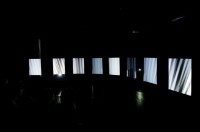FLORENCE TO AND ALEX SMOKE
(Selig Hecht was the inspiration on research of dark adaptation)
Fovea
source: triangulationblog
Fovea by Florence To
“Working on the positioning and distance of light, sectioned on multiple reflective surfaces, the installation is focused on the idea of dark adaptation and how the contrast with light movements and illumination can heighten our senses. Sound will reflect on the repositioning of light on each reflected panel to create an intensified live performance.” – Florence To.
Installation inspired by the research of Dark Adaptation by Biophysics Professor Selig Hecht with sounds designed by Alex Smoke. Photography by Gordon Burniston.
.
.
.
.
.
.
source: florence-to
“The result is a clean cut transition…he merely raises
his head 5cms when the lights are turned off and is at once ready for measurement”
How long can we respond to our visual perceptions and sound together? Working on the positioning and distance of light, sectioned on multiple reflective surfaces, the installation will be focusing on the idea of dark adaptation and how the contrast with light movements and illumination can heighten our senses. Sound will reflect on the repositioning of light on each reflected panel to create an intensified live performance.
Installation was created by Florence To in collaboration with Sound Designer Alex Smoke. Fovea was designed in research of Dark Adaptation by Biophysics Professor Selig Hecht.
The Installation has been designed with the functionality to be repositioned within a space and the portability for easy transportation.
What is Dark Adaptation? – During the dark adaptation of the human eye, its visual threshold decreases to a small fraction of its original value in the light. The visual reception in dim light is conditioned by a reversible photochemical reaction involving a photosensitive substance (light) and its two products of decomposition. Dark adaptation depends on the course of the “dark” reaction during which the two products of decomposition reunite to synthesize the original photosensitive substance.
“Providing a constant background upon which a stimulus can be superimposed: an absolute threshold upon the dark-adapted state, a differential threshold upon the light-adapted state. Hecht had written equations for the steady state; and by assuming that the visual threshold, absolute or differential, corresponds to a constant increment in the rate of breakdown of photosensitive material, he could extend his treatment to departures from the steady state the phenomena encountered in brightness discrimination, the response to flickering light, and the absolute threshold.
Before he started any experiments in human dark adaptation, visual acuity, intensity discrimination, or colour vision, he had already published theoretical approaches to these functions on the basis of existing data. Having repeatedly been frustrated by incomplete or inadequate information, he was determined that measurements from his own laboratory should be precise and exhaustive.” Notes taken from Biographical Memoirs V.60 By National Academy of Sciences
SOUND DESIGN
The sound design for Fovea is largely done in the Kyma environment, manipulating sounds using a lot of different processes such as Resynthesis, Granular, FM and Spectral. The composition involves creating tones covering the gamut from dark and claustrophobic, to sharp and bright with movement from synthetic to natural sounds over the course of the piece. Momentum is maintained by rhythmic percussion then sliced into tiny sections to be sequenced in a sampler. A running sequence also helps to maintain forward movement that is handled by Aalto, which takes care of the synthesiser string parts, before the orchestral strings come in at the end. Everything is sequenced within Logic.


